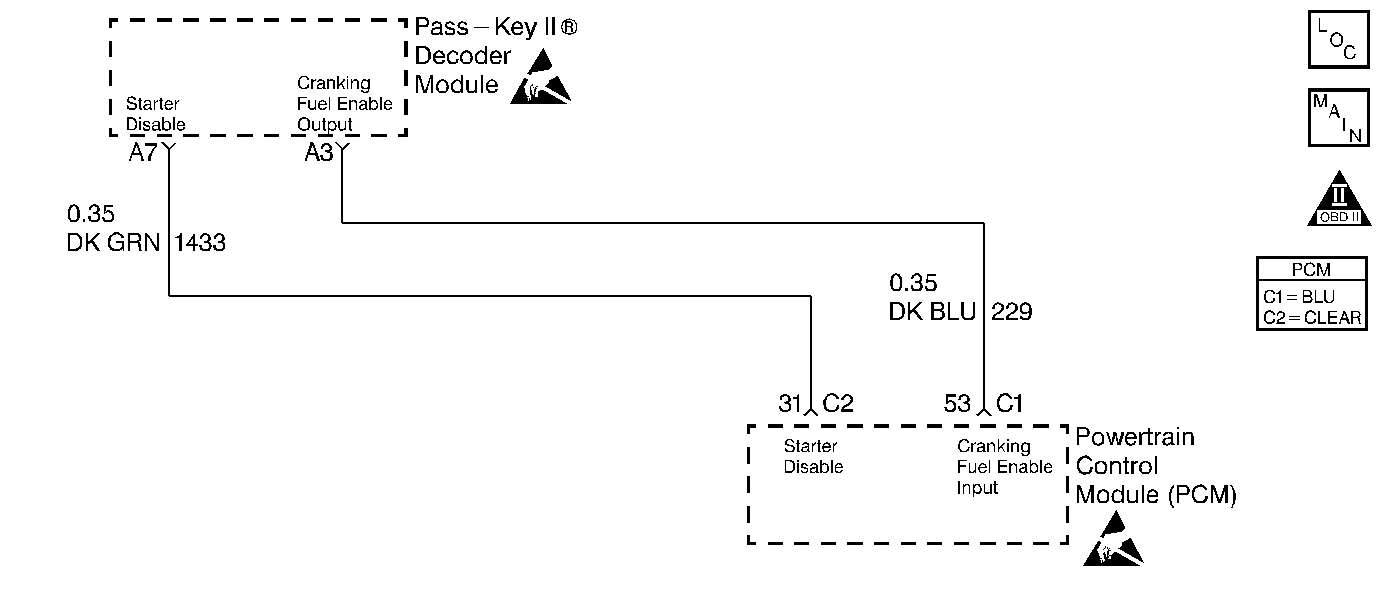
Circuit Description
DTC P1626 is an indication that the fuel enable input to the PCM has failed in a given cycle. The PASS-Key® system enables engine operation by allowing the starter motor to engage and issuing a fuel enable signal to the PCM. If a failure is present at the end of the fuel decision point this could cause a no start. Additionally, the PCM will not disable fuel injection after it has been enabled within a given ignition cycle to prevent stalling as a result of PASS-Key® system failures.
Conditions for Setting the DTC
Test Condition
PASS-Key® engine start timer expired.
Failure Condition
PASS-Key® Fuel Enable Input has not been received within the fuel decision time period.
Action Taken When the DTC Sets
| • | PCM will enable fuel injection on future ignition cycles regardless of the PASS-Key® enable input status. |
| • | The Malfunction Indicator Lamp (MIL) will not illuminate. |
| • | The PCM will command a message to be displayed. |
| • | The PCM may record operating conditions at the time the diagnostic fails. This information will be stored in the Failure Records. |
Conditions for Clearing the DTC
| • | A History DTC will clear after forty consecutive warm-up cycles with no failures of any non-emission related diagnostic test. |
| • | A Last Test Failed (current) DTC will clear when the diagnostic runs and does not fail. |
| • | Use a scan tool to clear DTCs. |
| • | Interrupting PCM battery voltage may or may not clear DTCs. This practice is not recommended. Refer to Clearing Diagnostic Trouble Codes in PCM Description and Operation. |
Diagnostic Aids
An intermittent setting of DTC P1626 could be caused by an intermittent open/short to ground or short to voltage on CKT 229.
An intermittent no start could be caused by loss of power or ground to the Passkey II module. Since the Passkey II module samples the ignition key resistor pellet only once per ignition cycle (at key ON) faults of the Passkey II system cannot cause a stalling problem.
Step | Action | Value(s) | Yes | No |
|---|---|---|---|---|
1 | Was the Powertrain On-Board Diagnostic (OBD) System Check performed? | -- | Go to A Powertrain On Board Diagnostic (OBD) System Check | |
2 | Attempt to start the vehicle. Does the vehicle crank? | -- | Go to Section 8, Electrical . | |
3 |
Is the voltage between the values specified? | 2 - 6 volts | ||
4 |
Is the frequency between the values specified? | 40 - 60 Hz | ||
5 |
Does the vehicle start? | -- | Fault not present. Refer to Diagnostic Aids | |
6 |
Is the resistance the same or less than the value specified? | 5 ohms | ||
7 | Measure the resistance to ground at PCM connector C1 terminal 53. Is the resistance more than the value specified? | 10K ohms | ||
8 |
Was terminal contact repaired? | -- | Go to Powertrain Control Module Diagnosis for Verify Repair | |
9 | Replace the Passkey II module. Refer to Section 9, Theft Deterrent Systems . Is the replacement complete? | -- | Go to Powertrain Control Module Diagnosis for Verify Repair | -- |
10 | Repair the open in the Fuel Enable Input circuit. Is the repair complete? | -- | Go to Powertrain Control Module Diagnosis for Verify Repair | -- |
11 | Repair the short to ground in the Fuel Enable Input circuit. Is the repair complete? | -- | Go to Powertrain Control Module Diagnosis for Verify Repair | -- |
12 |
Was terminal contact repaired? | -- | Go to Powertrain Control Module Diagnosis for Verify Repair | |
13 | Replace the PCM. Refer to PCM Replacement/Programming . Is the replacement complete? | -- | Go to Powertrain Control Module Diagnosis for Verify Repair | -- |
